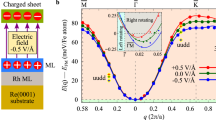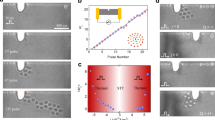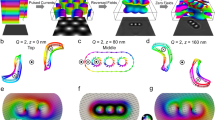Abstract
When an electron moves in a smoothly varying non-collinear magnetic structure, its spin orientation adapts constantly, thereby inducing forces that act both on the magnetic structure and on the electron. These forces may be described by electric and magnetic fields of an emergent electrodynamics1,2,3,4. The topologically quantized winding number of so-called skyrmions—a type of magnetic whirl discovered recently in chiral magnets5,6,7—has been predicted to induce exactly one quantum of emergent magnetic flux per skyrmion. A moving skyrmion is therefore expected to induce an emergent electric field following Faraday’s law of induction, which inherits this topological quantization8. Here we report Hall-effect measurements that establish quantitatively the predicted emergent electrodynamics. We obtain quantitative evidence for the depinning of skyrmions from impurities (at current densities of only 106 A m−2) and their subsequent motion. The combination of exceptionally small current densities and simple transport measurements offers fundamental insights into the connection between the emergent and real electrodynamics of skyrmions in chiral magnets, and might, in the long term, be important for applications.
This is a preview of subscription content, access via your institution
Access options
Subscribe to this journal
Receive 12 print issues and online access
$259.00 per year
only $21.58 per issue
Buy this article
- Purchase on SpringerLink
- Instant access to full article PDF
Prices may be subject to local taxes which are calculated during checkout



Similar content being viewed by others
References
Volovik, G. Linear momentum in ferromagnets. J. Phys. C 20, L87 (1987).
Yang, S. A. et al. Universal electromotive force induced by domain wall motion. Phys. Rev. Lett. 102, 067201 (2009).
Hai, P. N., Ohya, S., Tanaka, M., Barnes, S. E. & Maekawa, S. Electromotive force and huge magnetoresistance in magnetic tunnel junctions. Nature 458, 489–492 (2009).
Barnes, S. E. & Maekawa, S. Generalization of Faraday’s law to include nonconservative spin forces. Phys. Rev. Lett. 98, 246601 (2007).
Mühlbauer, S. et al. Skyrmion lattice in a chiral magnet. Science 323, 915–919 (2009).
Neubauer, A. et al. Topological Hall effect in the A phase of MnSi. Phys. Rev. Lett. 102, 186602 (2009).
Yu, X. Z. et al. Real-space observation of a two-dimensional skyrmion crystal. Nature 465, 901–904 (2010).
Zang, J., Mostovoy, M., Han, J. H. & Nagaosa, N. Dynamics of skyrmion crystals in metallic thin films. Phys. Rev. Lett. 107, 136804 (2011).
Adams, T. et al. Long-range crystalline nature of the skyrmion lattice in MnSi. Phys. Rev. Lett. 107, 217206 (2011).
Münzer, W. et al. Skyrmion lattice in the doped semiconductor Fe1−xCoxSi. Phys. Rev. B (R) 81, 041203 (2010).
Pfleiderer, C. et al. Skyrmion lattices in metallic and semiconducting B20 transition metal compounds. J. Phys. Condens. Matter 22, 164207 (2010).
Bogdanov, A. N. & Yablonskii, D. A. Thermodynamically stable ‘vortices’ in magnetically ordered crystals. The mixed state of magnets. Sov. Phys. JETP 68, 101–103 (1989).
Heinze, S. et al. Spontaneous atomic-scale magnetic skyrmion lattice in two dimensions. Nature Phys. 7, 713–718 (2011).
Jonietz, F. et al. Spin transfer torques in MnSi at ultra-low current densities. Science 330, 1648–1651 (2010).
Grollier, J. et al. Switching a spin valve back and forth by current-induced domain wall motion. Appl. Phys. Lett. 83, 509–511 (2003).
Tsoi, M., Fontana, R. & Parkin, S. Magnetic domain wall motion triggered by an electric current. Appl. Phys. Lett. 83, 2617–2619 (2003).
Yamanouchi, M., Chiba, D., Matsukura, F. & Ohno, H. Current-induced domain-wall switching in a ferromagnetic semiconductor structure. Nature 428, 539–542 (2004).
Bauer, A. et al. Quantum phase transitions in single-crystal Mn1−xFexSi and Mn1−xCoxSi: Crystal growth, magnetization, ac susceptibility, and specific heat. Phys. Rev. B 82, 64404 (2010).
Larkin, A. I. & Ovchinnikov, Y. N. Electrodynamics of inhomogeneous type-II superconductor. Sov. Phys. JETP 38, 854–858 (1974).
Schmid, A. & Hauger, W. On the theory of vortex motion in an inhomogeneous superconducting film. J. Low Temp. Phys. 11, 667–685 (1973).
Zhang, S. & Zhang, S. S-L. Generalization of the Landau–Lifshitz–Gilbert equation for conducting ferromagnets. Phys. Rev. Lett. 102, 086601 (2009).
Blatter, G., Feigel’man, M. V., Geshkenbein, V. B., Larkin, A. I. & Vinokur, V. M. Vortices in high-temperature superconductors. Rev. Mod. Phys. 66, 1125–1388 (1994).
Brazovskii, S. & Nattermann, T. Pinning and sliding of driven elastic systems: Domain walls and charge density waves. Adv. Phys. 53, 177–253 (2004).
Kopnin, N. Vortex dynamics and mutual friction in superconductors and Fermi superfluids. Rep. Prog. Phys. 65, 1633–1678 (2002).
Neubauer, A. et al. Ultra-high vacuum compatible image furnace. Rev. Sci. Instrum. 82, 013902 (2010).
Welter, B. Tunnelspektroskopie an Korngrenzenkontakten aus elektronendotierten Hochtemperatur–Supraleitern. PhD thesis, Technische Univ. München (2007).
Acknowledgements
We wish to thank P. Böni, H. Hagn, N. Nagaosa, T. Nattermann, S. Mayr, M. Opel, B. Russ, B. Spivak, G. Stölzl and V. M. Vinokur for helpful discussions and support. R.R., A.B., M.W. and C.F. acknowledge financial support through the TUM Graduate School. K.E. acknowledges financial support through the Deutsche Telekom Stiftung and the Bonn Cologne Graduate School. Financial support through Deutsche Forschungsgemeinschaft TRR80, SFB608 and FOR960 is gratefully acknowledged.
Author information
Authors and Affiliations
Contributions
T.S., R.R. M.H., M.W. and C.P. developed the experimental set-up; T.S. and R.R. performed the experiments; T.S., R.R. and C.P. analysed the experimental data; C.F. wrote the software for analysing the data; A.B. grew the single-crystal samples and characterized them; K.E., M.G. and A.R. developed the theoretical interpretation; C.P. supervised the experimental work; C.P. and A.R. proposed this study and wrote the manuscript; all authors discussed the data and commented on the manuscript.
Corresponding authors
Ethics declarations
Competing interests
The authors declare no competing financial interests.
Supplementary information
Supplementary Information
Supplementary Information (PDF 1113 kb)
Rights and permissions
About this article
Cite this article
Schulz, T., Ritz, R., Bauer, A. et al. Emergent electrodynamics of skyrmions in a chiral magnet. Nature Phys 8, 301–304 (2012). https://doi.org/10.1038/nphys2231
Received:
Accepted:
Published:
Issue date:
DOI: https://doi.org/10.1038/nphys2231
This article is cited by
-
Ordered creation and motion of skyrmions with surface acoustic wave
Nature Communications (2023)
-
Transition between distinct hybrid skyrmion textures through their hexagonal-to-square crystal transformation in a polar magnet
Nature Communications (2023)
-
Bloch points and topological dipoles observed by X-ray vector magnetic tomography in a ferromagnetic microstructure
Communications Physics (2023)
-
Topological magneto-optical effect from skyrmion lattice
Nature Communications (2023)
-
Machine learning assisted derivation of minimal low-energy models for metallic magnets
npj Computational Materials (2023)



